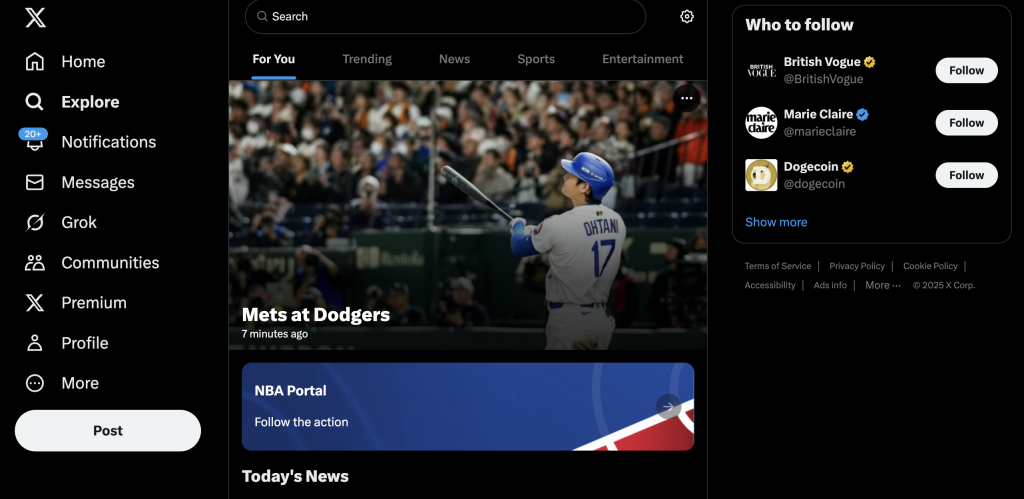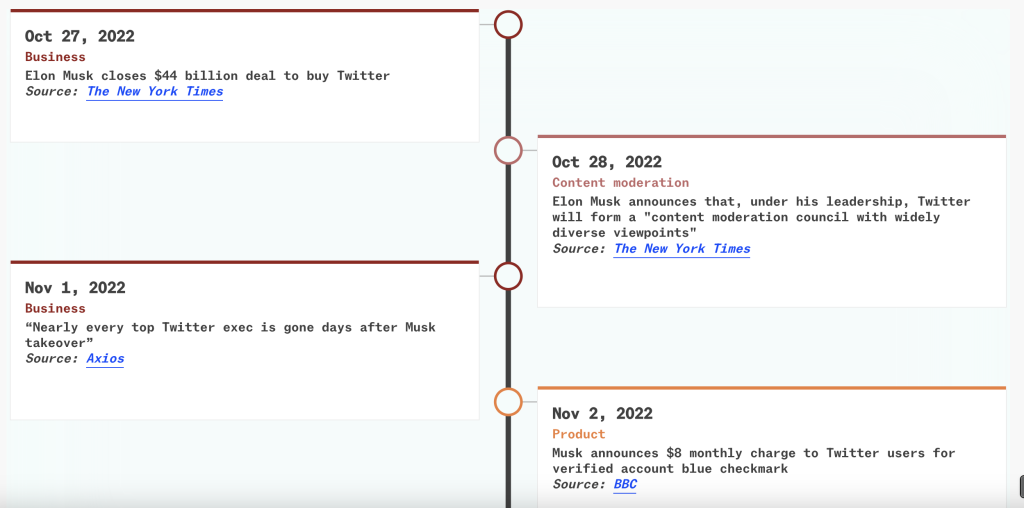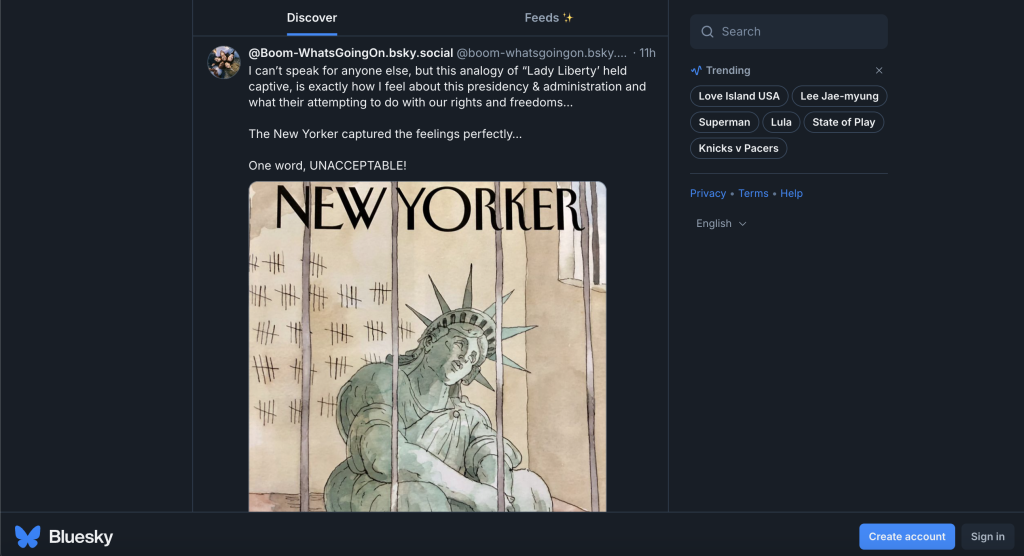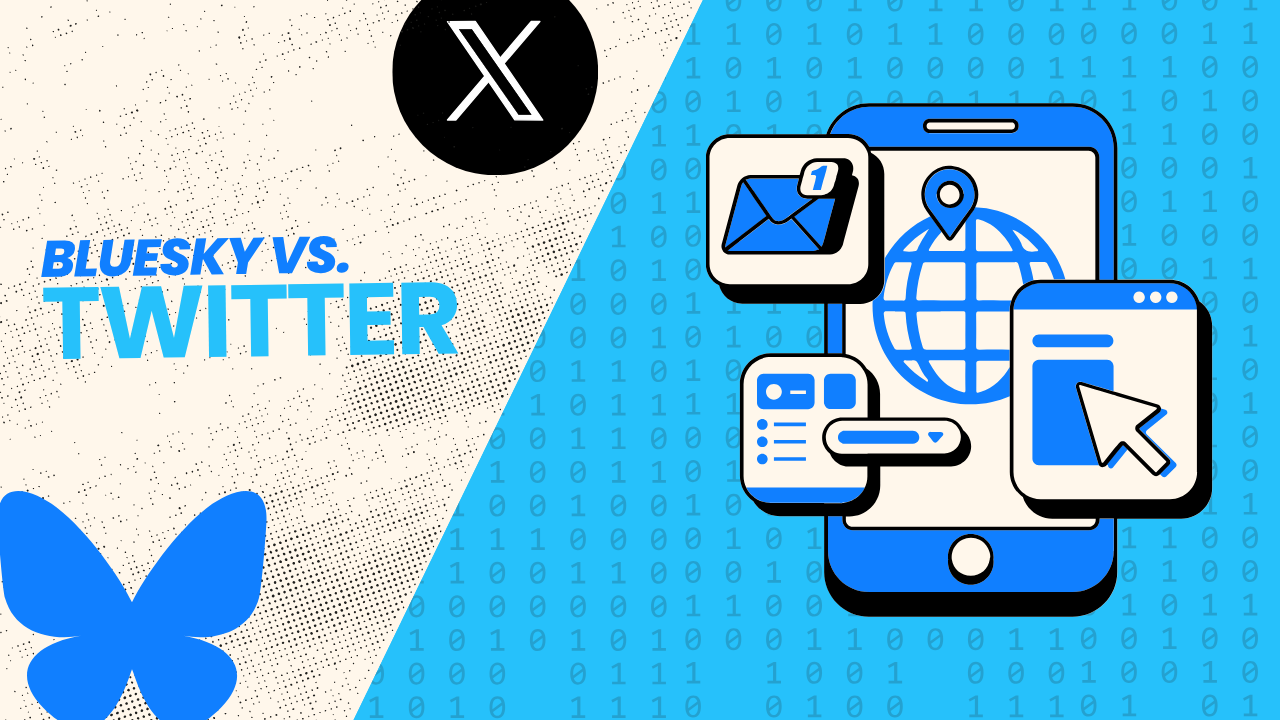As social media keeps evolving, creators and brands are exploring fresh platforms to grow their audience and income.
One big question in 2025: Is it time to leave Twitter (now X) for Bluesky? With Elon Musk continuing to change Twitter and Bluesky quickly gaining buzz, this guide breaks down what you need to know about Bluesky vs Twitter.
We’ll walk you through what Bluesky is, how it compares to Twitter, and whether it’s the right time to switch or double down.
Whether you’re a brand, influencer, or content creator, this breakdown will help you make a smart move for your social media presence.
Key Takeaways
- Bluesky is a decentralized social platform with customizable feeds and growing appeal among creators.
- Twitter/X still offers larger reach and monetization but comes with brand safety concerns.
- Most users should maintain both platforms for reach and experimentation in 2025.
What Is Bluesky and How Did It Emerge?

Bluesky is a new social media platform launched in 2023 and backed initially by Twitter co-founder Jack Dorsey. Unlike traditional platforms, Bluesky is built on the AT Protocol, which promotes decentralization.
That means users have more control over their content, data, and the algorithms that display their posts.
Bluesky’s goal is to make social networking open and customizable. Think of it like email: anyone can build a client, and users can switch between them.
This makes the new social media platform more creator-friendly and avoids platform lock-in.
The platform first launched as invite-only, creating buzz and exclusivity. As of 2025, it’s now open to the public and gaining traction with users who are frustrated with Twitter’s direction.
Twitter/X: What Has Changed Since Elon Musk’s Takeover?

Since Elon Musk’s acquisition of Twitter in late 2022, the platform has undergone a radical transformation structurally, culturally, and functionally. The shift has been so dramatic that Twitter has even been rebranded as simply “X.”
These changes have sparked intense debate across user communities, advertisers, and the tech world at large.
Major Changes on the Platform
Here are some of the main ways that Musk has affected Twitter and what X has become as a result.
- Rebranding to X: The iconic Twitter brand was officially retired. The move signaled Musk’s larger vision of transforming the platform into an “everything app” — combining social media, payments, and AI.
- Paid Verification: Blue checkmarks, once reserved for notable figures, are now available to anyone paying for X Premium. This has diluted trust and credibility while sparking impersonation issues. In the past, they were not for sale.
- Relaxed Moderation: Musk’s “free speech absolutism” has resulted in lighter content moderation. Critics say this has led to a rise in hate speech, harassment, and misinformation.
- Algorithm Overhauls: The For You feed now aggressively prioritizes engagement — often favoring polarizing, viral, or controversial content over nuanced or educational posts. This could have a negative impact on your Twitter content reach.
- Monetization Tools: X introduced ad revenue sharing and subscription options for creators. While some earn substantial payouts, income remains inconsistent and skewed toward viral or sensational accounts.
- Workforce and Tech Shifts: Mass layoffs and infrastructure changes have led to periods of instability, frequent outages, and concerns about long-term support and innovation.
These changes have created a mixed experience for users and businesses. On one hand, Twitter/X remains a top-tier destination for breaking news, real-time conversation, and public visibility.
On the other hand, its chaotic management, policy volatility, and content risks have made it less dependable for long-term brand building.
You can check out a full timeline of Elon Musk’s chaotic behavior if you are so inclined! Thanks Sherwood News.

For creators, Twitter monetization options are appealing, but the algorithms tend to reward outrage and controversy more than creativity or consistency. This is not always the case, but something to keep in mind.
For brands, increased brand safety concerns and ad placement near questionable content have driven many to pause or reduce their presence.
In short: Twitter/X is still highly influential, but it’s no longer stable ground. The platform may help you go viral, but it may also put your brand in unexpected and sometimes damaging contexts.
These changes have driven some users to leave the platform. Others stay, but many are exploring alternatives like Bluesky, Mastodon, and Threads.
Bluesky vs Twitter/X: Key Differences
Here are some of the biggest differences between the two platforms:
| Feature | Bluesky | Twitter/X |
| Ownership | Community-driven via open protocol | Privately owned by Elon Musk |
| Feed | Customizable and open-source | Algorithmic, engagement-driven |
| Moderation | User-controlled tools and community standards | Centralized, controversial enforcement |
| Monetization | Still developing, but decentralized tools expected | Ad revenue sharing, subscriptions (X Premium) |
| Account Portability | Yes — users can switch between Bluesky clients | No — your account and data stay on X |
| Ads | Currently ad-free | Heavy ad presence and sponsored content |
| User Base (2025) | Over 15 million and growing | 300+ million active users but slowing growth |
The chart shows that while Twitter/X dominates in size and monetization, Bluesky offers users greater control, cleaner user experiences, and future-facing customization.
For creators and developers, Bluesky’s openness is a major selling point. However, Twitter/X still commands far more attention and media integration, which can’t be ignored by businesses aiming for broad reach.
In 2025, it’s a classic trade-off: control and community vs. scale and exposure.
Bluesky vs Twitter: Pros and Cons for Users & Brands

It’s important to consider all of the facts when making a decision about Bluesky vs Twitter. For that reason, we’re highlighting all of the pros and cons of each social media network.
Here’s a more detailed look at the strengths and weaknesses of each platform, broken down by pros and cons for users and brands with final considerations.
Bluesky Pros:
If you’re looking for a cleaner, more innovative space to grow your community, Bluesky has a lot to offer.

- Custom Feeds: You can follow feeds built around specific interests or communities
- No Ads (Yet): The current experience is clean and user-focused
- Open Ecosystem: Brands and developers can build on the AT Protocol
- Better Privacy: Less data harvesting than Twitter/X
- More Positive Vibes: The tone is less hostile, more like early Twitter
Bluesky Cons:
Despite its potential, Bluesky still lacks some critical tools for creators and brands.
- Limited Monetization (For Now): No built-in way to earn money from posts.
- Smaller Audience: Great for niche engagement, but not yet for mass reach.
- Still Developing: Features like DMs, trends, or advanced analytics are limited.
Twitter/X Pros:
Twitter/X remains a powerful tool for exposure, monetization, and mainstream visibility.
- Massive Reach: Still one of the largest social platforms
- Monetization Tools: Ad revenue sharing, subscriptions, brand partnerships and Twitter analytics are all very strong
- Media Visibility: Journalists, brands, and news still rely heavily on Twitter/X
- Spaces & Video: Live audio and video tools are well integrated
Twitter/X Cons:
However, the platform comes with increasing risks for creators and brands alike.
- Toxic Environment: Increase in trolling and extreme content
- Unpredictable Changes: Policy shifts often happen overnight
- Paywalls and Promotions: Feels more like a monetized machine than a social space
Ultimately, Bluesky shines as a creative and customizable alternative that’s still finding its footing, while Twitter/X remains the heavyweight champion of visibility and monetization, even with all the baggage that comes with it.
For most creators and brands in 2025, a balanced presence on both platforms allows you to maximize reach while experimenting with the more forward-thinking features of Bluesky.

Is It Time to Leave Twitter/X?
It’s definitely not a cut and dry answer, and the decision lies completely with social media users. In part, the answer depends on your goals. We will present some different scenarios here to see if leaving Twitter is the best choice for you:
- Creators who want engagement and creativity: Bluesky is a great sandbox to test ideas without being drowned out. That said, you may not have as much engagement depending on your niche since there are less users on Bluesky than Twitter.
- Businesses looking for reach and visibility: Twitter/X is still a key platform for PR and customer service because it’s larger than Bluesky.
- Concerned about brand safety: Bluesky’s community-driven moderation may offer a safer image as opposed to Twitter’s volatile nature.
- Trying to diversify audience: Maintaining a presence on both is smart since it allows two different platforms with different users to access your content. You still need Twitter followers while you grow your Bluesky.
- Ad-free experience: Some users prefer the ad-free nature of Bluesky, giving a cleaner vibe and more control over user timelines.
Leaving Twitter entirely might be too soon for most. But ignoring Bluesky could be a missed opportunity, especially if you’re building long-term trust with a forward-thinking audience.
FAQs: Bluesky vs Twitter / X
Still have some questions about the two social platforms and want a quick response? Take a look at our FAQ before making any final decisions.
Is Bluesky better than Twitter/X?
It depends. Bluesky offers more control and a less toxic environment, but Twitter/X still has broader reach and monetization tools. At the end of the day it’s all about personal preference.
Can I use Bluesky and Twitter/X at the same time?
Yes. Many creators and brands are active on both to reach different audiences and test content styles.
Is Bluesky completely free?
Yes, as of 2025, Bluesky is free to join and use. There are no ads or paid tiers (yet).
How do I join Bluesky?
If you’re interested in trying the platform, it’s easy. Go to https://bsky.app/, create an account, and start exploring. No invite is needed anymore.
What is the difference between Bluesky and Twitter?
Bluesky is decentralized and open-source. It gives users control over what they see, how their content is shared, and even which moderation standards to follow.
Does Bluesky have ads?
No. Currently, Bluesky is ad-free. Monetization options are still being explored.
Is Bluesky the New Twitter?
It’s unlikely to replace Twitter/X overnight, but Bluesky could become a major player, especially among creators and privacy-focused users.
Is Bluesky safer than Twitter/X?
In many ways, yes. Community-led moderation and a smaller user base make it less hostile. But as it grows, this could change.
Do businesses need to be on Bluesky?
Not yet essential, but smart brands are experimenting with it now to get ahead. Early adopters often benefit the most when platforms scale.
Final Thoughts: Bluesky vs Twitter
Social media isn’t one-size-fits-all anymore. While Twitter/X still holds major weight, Bluesky offers a refreshing, creator-friendly space that could shape the future.
If you’re a business or creator, the best move in 2025 is likely both— keep a presence on Twitter/X for reach and media ties, and start building on Bluesky for community, creativity, and future growth.
The earlier you plant roots in Bluesky, the more likely you’ll benefit as it scales. Don’t wait until it’s saturated. Test, engage, and see what works for your audience.
Twitter isn’t going anywhere anytime soon, so if you want to get more Twitter followers and focus on your growth, that’s a viable option as well.


